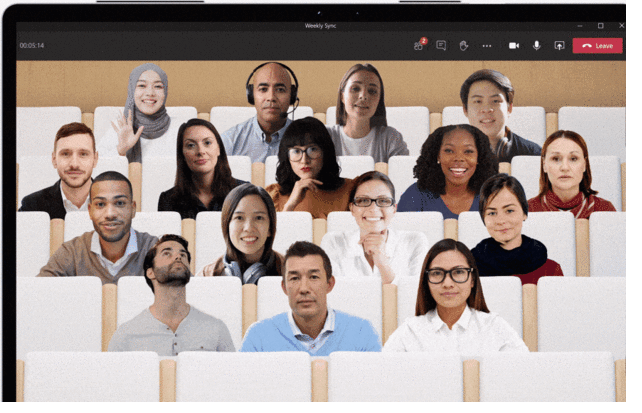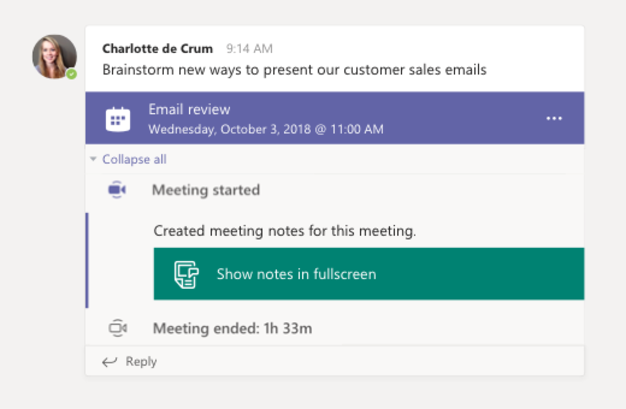Elena Canorea
Communications Lead
Actualizado en junio 2022
Microsoft Teams es una solución diseñada para convertirse en el núcleo de toda la actividad de una empresa. Se trata de una herramienta que Microsoft incorporó a finales de 2016 a la ya robusta suite de Microsoft 365 (antiguamente Office 365). Esto significa que, más allá de sus propias funcionalidades, ofrece una integración total con las otras soluciones de la suite: Outlook, Word, Excel, One Drive, PowerPoint, Power BI…
Basada en la nube, Microsoft Teams permite a las empresas modernizar su forma de trabajar gracias a 4 pilares indispensables para cualquier empresa actual.
Haz que el equipo esté al tanto de todo con los chats de grupo, las reuniones online, las llamadas, conferencias…
Colabora en archivos con las aplicaciones integradas de Microsoft 365 como Word, Excel, PowerPoint y SharePoint.
Agrega tus aplicaciones favoritas de Microsoft y los servicios de terceros para acceder a todos los recursos que necesitas.
Obtén la seguridad de extremo a extremo, el control administrativo y el cumplimiento, todo con tecnología de Microsoft 365.
Descargar Microsoft Teams gratis es tan sencillo como acceder a la web de Microsoft y clicar en el botón con la versión más adecuada a nuestras necesidades: escritorio o dispositivo móvil. Si accedes a esta página desde un ordenador portátil o de sobremesa, puedes escribir tu dirección de correo electrónico para recibir un enlace de descarga con el que instalarla en tu móvil.
También en esa página es posible encontrar las dos versiones gratuitas existentes: para el hogar y pequeñas empresas o para los sectores laboral y educativo.
Iniciar sesión en Teams depende del dispositivo que estemos usando:
Tras ello, introduce tu nombre de usuario y tu contraseña.
Además de para Mac, Microsoft Teams está disponible para Linux. La versión de escritorio está disponible para los formatos .deb y .rpm. Teams se distribuye cada mes; el administrador de paquetes debería instalar las actualizaciones automáticamente.
Cómo lo hago: Accedemos a la página oficial de descarga de Microsoft. Si estamos en un ordenador con Ubuntu, el sistema lo detectará automáticamente y nos mostrará las versiones para descargar en nuestra máquina. Una vez hecho y al clicar sobre él, un asistente realizará el proceso automáticamente.
Otra opción es la instalación manual mediante comandos. Tienes más información sobre ello en la web oficial de Microsoft.
A continuación, te dejamos con el tutorial de Microsoft Teams que repasa aquellas funcionalidades de mayor interés.

Los propietarios y los miembros de Teams pueden agregar pestañas adicionales a cada canal para personalizarlos y que ofrezcan los servicios disponibles a sus necesidades.
En los canales, las pestañas de Conversaciones y Archivos se crean de forma predeterminada. Del mismo modo ocurre en cada chat privado: las pestañas de Conversaciones, Archivos, Organización y Actividad se crean de forma predeterminada. Sin embargo, además de estas pestañas integradas, puedes diseñar y agregar pestañas personalizadas, como incorporar un archivo Excel, Word, Power BI…
Cómo lo hago: Simplemente tienes que clicar en el símbolo «+» que aparece en el menú superior de un chat e incorporar para ese chat o grupo aquella funcionalidad que necesites.
Los bookmarks te permiten guardar un mensaje o un archivo adjunto para leerlo más tarde, o simplemente tenerlo marcado como un recurso importante. Algo muy útil en archivos o mensajes importantes a los que vamos a tener que recurrir en el futuro.
Cómo lo hago: En un chat, busca el mensaje o archivo que deseas marcar y haz clic en el icono del marcador que aparece al pasar el puntero sobre el mensaje. Para encontrar los archivos que hayas marcado solo tienes que escribir en la barra de búsqueda “/guardada” y accederás a una lista de los elementos que has marcado.
Comparte tu escritorio, una ventana o un archivo de PowerPoint, o utiliza la pizarra si quieres mostrar tu pantalla y otras actividades y ficheros de tu escritorio al resto de asistentes de una reunión.
Cómo lo hago: Para compartir la pantalla en una reunión, selecciona «Compartir pantalla» en los controles de la reunión. Después, solo tienes que decidir si quieres presentar todo el escritorio, una ventana en concreto, un archivo de PowerPoint…
Si eliges compartir un archivo de PowerPoint en una reunión, los participantes podrán desplazarse por las diferentes diapositivas sin interrumpir la presentación principal. Y siempre que lo deseen, podrán volver a la vista del presentador con un solo clic.
Cómo lo hago: Selecciona «Compartir pantalla» en los controles de la reunión. En la sección PowerPoint, escoge el archivo que desees compartir.
El uso compartido del audio del sistema te permite transmitir el audio de tu equipo a los participantes de la reunión a través de Teams. Puedes usarlo para reproducir un clip de audio o vídeo como parte de una presentación.
Cómo lo hago: Para compartir el audio del sistema, selecciona «Compartir pantalla» en los controles de la reunión. Después, solo tienes que activar la opción «Incluir audio del sistema».
La integración de Whiteboard en las reuniones de Microsoft Teams está impulsada por Whiteboard para la Web, que permite a los participantes de las reuniones de Teams dibujar, esbozar y escribir juntos en un lienzo digital compartido.
Cómo lo hago: Puedes compartir una pizarra para que esté disponible simultáneamente en las aplicaciones de pizarra en Windows 10, iOS y en la Web. Después de unirse a una reunión de Teams, selecciona «Compartir» en la bandeja de uso compartido de la reunión. Y en la sección «Pizarra», escoge Microsoft Whiteboard.
Puedes abrir la misma pizarra en las aplicaciones de pizarra de Microsoft para Windows 10 o iOS para añadir cualquier contenido y hacer uso del lápiz.
Cómo lo hago: Al iniciar Whiteboard, los asistentes a la reunión de Teams podrán dibujar en él. Clica en el icono del lápiz, selecciona un color y apunta todo lo que desees.
Con Teams puedes realizar videollamadas para mantener reuniones o crear conversaciones mucho más dinámicas que en el modo chat. Estas videollamadas pueden hacerse con tantos miembros como desees, y pueden grabarse para todos aquellos que no hayan podido asistir a la reunión.
Cómo lo hago: Abre el chat con la persona o el grupo con quienes deseas iniciar la videollamada y haz clic en el icono de vídeo situado en la parte superior derecha.
En Microsoft Teams tienes la posibilidad de difuminar todo lo que queda a tu espalda cuando realizas una videollamada.
Cómo lo hago: Para activar el desenfoque de fondo únicamente debes acceder a una videollamada, clicar sobre el icono «Más Opciones (…)» y seleccionar la opción «Desenfocar fondo».
*Además, si lo que deseas es personalizar el fondo con imágenes propias, puedes visitar este artículo, donde te detallamos cómo hacerlo.

El organizador de un evento en directo puede programar uno en Teams Live desde el escritorio o la web. Este proceso agregará automáticamente el evento en los calendarios de tu grupo, lo que facilitará el recordatorio de la reunión a los asistentes antes de que esta empiece.
Cómo lo hago: En Teams, haga clic en «Reuniones», en el lado derecho de la aplicación y, a continuación, haga clic en «Programar una reunión» en la parte superior del cuadro.
Cuando crees una reunión para un canal, todos los miembros del equipo podrán verla y unirse a ella en él. Los canales no se pueden editar ni se pueden agregar después del envío de la invitación. Tendrá que enviar una nueva invitación con los canales actualizados.
Cómo lo hago: Selecciona «Nueva reunión». Escribe el nombre de un solo canal donde se indica «Agregar un canal» (en los campos de fecha y hora).
No es necesario tener cuenta en Microsoft Teams para acceder a reuniones en esta plataforma.
Cualquiera que reciba una invitación a una reunión podrá unirse a una sesión de Microsoft Teams. Tras clicar el enlace, se abrirá una página web, en la que verás dos opciones: descargar la aplicación de Windows o unirse a la reunión vía web. Al unirse mediante web, puedes usar Microsoft Edge o Google Chrome.
Cómo lo hago: Escribe tu nombre y elige la configuración de audio y vídeo. Si la sala de reuniones (u otro dispositivo conectado a la reunión) está cerca, elige «Audio OFF» para evitar interrupciones. Selecciona «Audio del teléfono» si deseas escuchar la reunión en tu teléfono móvil.
En ocasiones, necesitamos acceder a información de un canal o chat de la forma más rápida posible. ¡Es muy sencillo y funciona para chats de grupo y privados!
Cómo lo hago: Ve al chat o al canal, presiona Ctrl + F (o CMD + F para Mac) y luego escribe lo que quieras buscar. Obtendrás resultados de solo ese canal o chat.
Hay diversas formas de crear grupos en Teams:
Al generar un equipo, se crea automáticamente su grupo de Microsoft 365, que contiene una bandeja de entrada, un calendario de Outlook, OneNote y un espacio de SharePoint. Los equipos pueden ser público o privados.
Cómo lo hago: En la parte izquierda de la aplicación, clica en «Equipos» o ve abajo del todo, a «Unirse a un equipo o crear uno». Una vez aparezca la tarjeta «Crear un equipo», pincha en «Crear un equipo» y escoge «Desde cero». Tras nombrarlo y escribir una descripción opcional, pinchamos en «Crear».
Puedes usar las plantillas de equipo y crear equipos optimizados para vuestra forma de trabajar. También hay algunas plantillas nuevas para la administración de proyectos, la incorporación de empleados y mucho más.
Cómo lo hago: Pulsa la pestaña “Equipos” del lado izquierdo y la opción “Unirse a un equipo o crear uno” en la parte inferior de la lista de equipos. En este momento, elige “Seleccionar desde una plantilla”, desplázate hacia abajo y elige una plantilla para tu nuevo equipo. Después de revisar la lista de canales y aplicaciones con las que se iniciará el nuevo, selecciona “Iniciar” en la parte inferior. Ya solo queda personalizar el nombre y los detalles del grupo y pulsar “Crear”.
Si te has cansado de ver la misma apariencia en tus videollamadas día tras día, ahora tienes la oportunidad de huir del aburrimiento y llevar a tu equipo desde el auditorio a un mundo invernal, un paraíso bajo el mar…
Cómo lo hago: Una vez que estés en el Modo conferencia, solo tienes que seleccionar «Cambiar escena», que encontrarás en la esquina inferior izquierda de la reunión.

La organización en una empresa es crucial, y puedes crear y hacer un seguimiento del trabajo de tu equipo con la aplicación de publicación de tareas. Esta integra tareas individuales con tecnología de Microsoft To Do y tareas de equipo con tecnología de Planner en un solo lugar.
Cómo lo hago: En la parte izquierda de tu Teams podrás encontrar la aplicación de «Tareas» o como una pestaña en un canal dentro de equipos individuales. Para activar Tareas para su organización, busca la aplicación «Tareas», selecciónala y, a continuación, haz clic en «Permitir».
Las aplicaciones que Teams va incorporando a la plataforma nos pueden ayudar en muchas tareas de nuestro día a día. Podrás mejorar la experiencia de tus reuniones de una forma rápida y sencilla.
Cómo lo hago: Abre los detalles de la reunión y selecciona el icono «+» en la parte superior. Luego, elige una aplicación y pulsa «Agregar».
Puedes programar reuniones como un equipo con este nuevo calendario. Ahora verás todos los eventos del canal en una ubicación y los agregarás a tu calendario personal.
Cómo lo hago: Selecciona Calendario en la parte izquierda de la aplicación. Después, pulsa «Agregar una pestaña», ve a «Calendario de canal» en la lista de aplicaciones disponibles y asigna un nombre al calendario. Solo quedaría seleccionar «Agregar» y ya podrás agregar reuniones a las que se unan todos los miembros.
Teams va agregando más idiomas a los subtítulos y traducciones de los eventos en directo. Tendrás subtítulos para el idioma hablado o subtítulos traducidos en el idioma que elijas.
Cómo lo hago: Para activar los subtítulos y subtítulos en vivo, selecciona el botón de subtítulos de los controles de vídeo. Para cambiar el idioma del epígrafe, selecciona configuración > subtítulos o subtítulos, y elige el idioma que quieras.
Si Teams es una herramienta ideal para reunir a equipos de cualquier lugar, el idioma no puede ser un obstáculo. Elimina cualquier barrera y trabaja con personas de todo el mundo gracias a la funcionalidad de traducción de mensajes.
Cómo lo hago: En un mensaje, haz clic en los puntos suspensivos y selecciona la opción «Traducir».
Ya sea que estamos en la oficina o teletrabajando en casa, a veces se cuelan en nuestras llamadas ruidos externos que pueden llegar a ser muy molestos y afectar a que la comunicación fluya sin ningún problema.
Cómo lo hago: Selecciona Configuración > Dispositivos > Supresión de ruido. Si el ruido es muy fuerte, tienes la opción «Alto» para una supresión aún mayor de sonidos de fondo.
Microsoft Teams facilita el uso compartido de archivos y el trabajo colaborativo sobre todo tipo de estos, al permitirte ver, editar y trabajar en equipo sobre ellos sin salir de Teams.
Cómo lo hago: Los archivos almacenados en la biblioteca de archivos de tu equipo son accesibles para todos los miembros del equipo. No es necesario comprobar los archivos ni preocuparte por si uno de tus compañeros tiene el documento abierto. Todos podéis trabajar al mismo tiempo e incluso ir viendo qué compañeros tienen el archivo abierto y qué cambios están realizando en este.
Es uno de los pasos más sencillos. Podrás actualizar en cualquier momento los archivos que compartas con tu equipo, para asegurarse de que tiene las últimas versiones de los archivos del grupo.
Cómo lo hago: Solo tienes que seleccionar la opción de “Sincronizar” y lo hará automáticamente.
Cualquier reunión o llamada de Teams puede grabarse para su posterior visualización. La grabación captura la actividad de audio, vídeo y pantalla compartida y se comparte de forma segura en toda la organización.
Cómo lo hago: Inicia una reunión o únete a ella. > Ve a los controles de la reunión y selecciona el botón «Más acciones». > Iniciar grabación.
En la configuración, ahora puedes elegir si iniciar un nuevo chat en la ventana principal de Teams o en una nueva.
Cómo lo hago: Ve a Configuración y a «Más opciones» en la parte superior de la aplicación > Configuración. Desplázate hacia abajo hasta «Abrir nuevo chat» > Nueva ventana. La próxima vez que inicies un nuevo chat, se abrirá automáticamente en una nueva ventana.
Si no te gusta la forma en la que te aparecen las notificaciones, no tienes por qué seguir con el mecanismo predeterminado. Los cambios se pueden hacer de una forma muy sencilla.
Cómo lo hago: Accede a tu imagen de perfil, selecciona Configuración > Notificaciones y ya está.
Las notas de la reunión ahora admiten hasta 100 participantes de la reunión a la vez. Los participantes que tienen acceso a las notas seguirán teniendo acceso a las notas de la reunión, incluso después de que finalice. Además, si alguien se une a la reunión después de que esté programada y no tiene acceso a las notas, ahora puede solicitar el acceso al propietario.
Cómo lo hago: Ve al calendario, elige una reunión, selecciona la pestaña «Notas de la reunión» y comienza a tomar notas de la reunión. Una vez que estés en la reunión, ve a «Más opciones» en los controles de la reunión y, a continuación, elige «Notas de la reunión». Si deseas obtener acceso a las notas desde una reunión de canal, ve al canal donde se produjo esta y búscala. Debajo de ella, selecciona «Mostrar notas en pantalla completa«.

Las notificaciones vienen predeterminadas, pero, para proporcionar aún más privacidad, Teams ahora permite desactivar las vistas previas de mensajes en las notificaciones de escritorio.
Cómo lo hago: Selecciona Configuración > Notificaciones > Mostrar vista previa de mensajes. Desde aquí, cambia el botón de «Alternancia» a «Desactivado».
Poner en primer plano un vídeo es como fijarlo para todos los usuarios de la reunión. Si eres un organizador o un moderador, puedes elegir un vídeo de cualquier persona para que sea el vídeo principal que vean los demás.
Cómo lo hago: Selecciona la opción «Mostrar participantes» para ver una lista de todos los participantes de la reunión. Busca el nombre de la persona cuyo vídeo deseas resaltar en la lista, haz clic con el botón derecho en su nombre y selecciona «Spotlight». Cuando estés listo para finalizar el foco, vuelve a hacer clic con el botón secundario y elige «Detener foco».
Muchas veces necesitamos saber quiénes conforman un canal. Ahora existe la opción de obtener una lista con los miembros que tienen acceso al canal y las personas que han contribuido recientemente a él.
Cómo lo hago: Solo tienes que pulsar en el símbolo «i», en la parte superior derecha del canal.
Puedes anclar una publicación importante para que tanto tú como tus compañeros la encuentren fácilmente. Si tienes instrucciones importantes de la empresa que todos deben tener en cuenta o si quieres hacer una celebración virtual, lo mejor es anclarlo y tener un acceso rápido a todos los detalles.
Cómo lo hago: Mantén el puntero del ratón sobre cualquier tipo de mensaje y selecciona Más opciones > Anclar.
Tienes la opción de que todos los usuarios, incluso las personas de tu organización, pasen por la sala de espera de reuniones cuando se unan a una reunión que hayas organizado.
Cómo lo hago: Abre «Opciones de reunión». Después, donde se pregunta «¿Quién puede omitir la sala de espera?», selecciona «Solo yo». Desde ahí podrás cambiar la configuración de los participantes en la reunión.
Desde Teams, puedes acceder a una vista detallada del organigrama de tu empresa. Mira la jerarquía organizativa, qué miembros forman parte de un equipo, quién es su responsable y el encaje de cada uno de los miembros de tu empresa.
Cómo lo hago: Abre un chat con un compañero de equipo y haz clic en la pestaña «Organización» que aparece en el menú superior. Se te mostrará un organigrama relativo a su posición dentro de la empresa.
Si te faltan las palabras, ahora puedes expresarte de otra forma. Además de levantar la mano virtualmente en una reunión, ahora es posible expresarse de otras formas como me gusta, me encanta, aplauso y risas. Esto ayudará a que las reuniones sean más inclusivas, atractivas y divertidas.
Cómo lo hago: Solo tienes que mantener el puntero sobre la opción de reacción en los controles de la reunión, en el área superior derecha de la pantalla, y se te desplegarán todas las nuevas reacciones. Selecciona la que quieras y aparecerá durante unos segundos en el vídeo o en la imagen de perfil en la esquina inferior derecha.
Ahora puedes volver a visitar las áreas anteriores en las que hayas estado en Teams. Accederás al historial de conversaciones, canales, aplicaciones, actividades, pestañas y archivos. Elige un elemento de la lista y volverás al instante a ese punto.
Cómo lo hago: Para acceder al historial, mantén el puntero sobre las fechas atrás-adelante situadas a la izquierda de la barra de búsqueda. Ahí es donde podrás elegir entre todas las áreas que hayas visitado recientemente.
Por si todo esto fuera poco, los bots son programas automatizados que responden a todo tipo de consultas o facilitan actualizaciones y notificaciones sobre detalles que puedan resultar interesantes para los usuarios: administración de tareas, encuestas, recordatorios, mejor momento para realizar reuniones…
Cómo lo hago: Debes clicar en los puntos suspensivos que aparecen al pasar el ratón por encima del nombre de cualquier grupo/chat y seleccionar «Administrar Aplicaciones». Aparecerán las aplicaciones/bots en funcionamiento en ese chat. Clicando sobre la pestaña «Más Aplicaciones» accederás al menú desde el que podrás añadir aquellos bots que te ayuden a realizar con mayor eficiencia tus tareas.
Algunos ejemplos:
Programar una reunión con el equipo puede resultar complicado. Verificar la disponibilidad de los compañeros no siempre es sencillo, puesto que las horas libres, en ocasiones, son escasas o inexistentes. Con el comando FreeTime 1, se mostrará una lista de las horas más adecuadas de los miembros del equipo, según sus calendarios.
Polly es el bot ideal para presentar encuestas, votaciones y sondeos que te faciliten el recopilar las opiniones de tus miembros de equipo.
Este bot resuelve un problema simple, pero recurrente. Como indica su nombre, te permite programar temporizadores en conversaciones, de manera que nos llamará la atención en un futuro sobre un tema en concreto que no queremos olvidar o que necesitamos recordar.
{«@context»: «https://schema.org», «@type»: «FAQPage», «mainEntity»: [{«@type»: «Question», «name»: «\u00bfQu\u00e9 es Microsoft Teams?», «acceptedAnswer»: {«@type»: «Answer», «text»: «\nMicrosoft Teams es una soluci\u00f3n dise\u00f1ada para convertirse en el n\u00facleo de toda la actividad de una empresa. Se trata de una herramienta que Microsoft… Click para seguir leyendo«}}]}
Elena Canorea
Communications Lead
